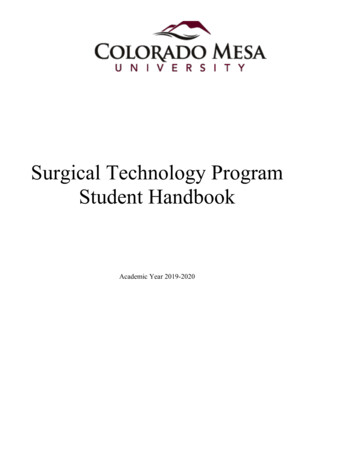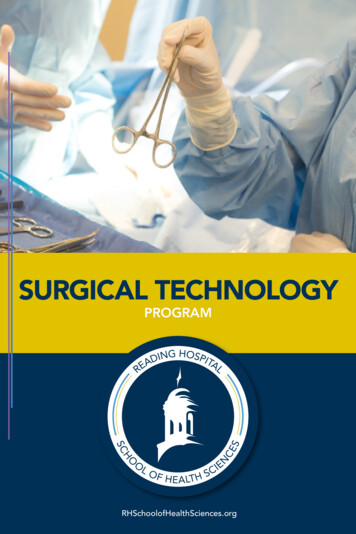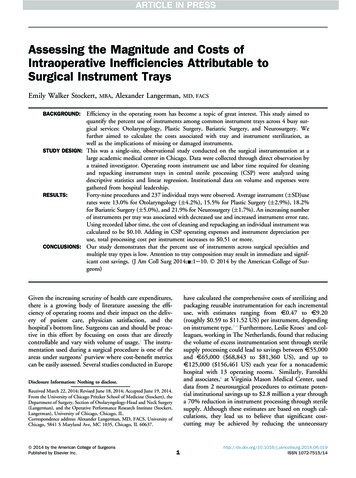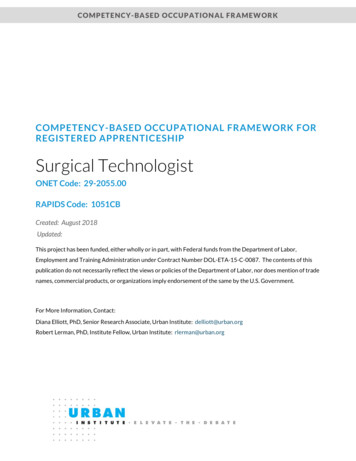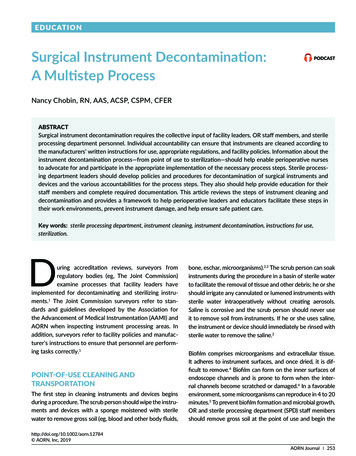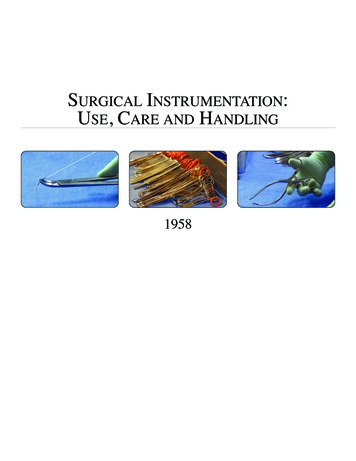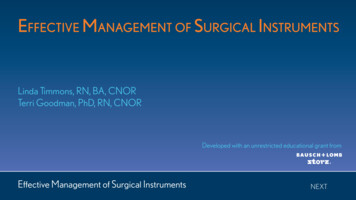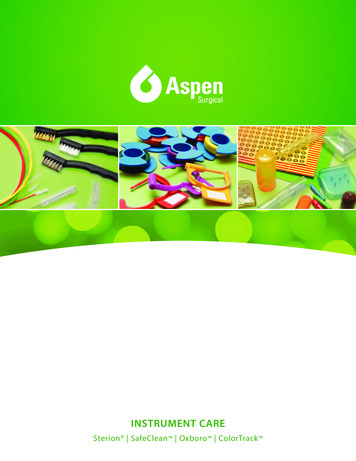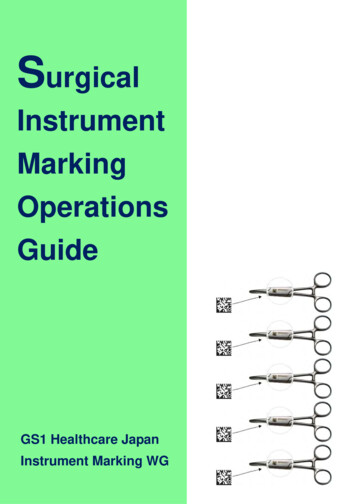
Transcription
SurgicalInstrumentMarkingOperationsGuideGS1 Healthcare JapanInstrument Marking WG
Copyright 2011 by GS1 Healthcare Japan, Instrument Marking WG and GS1 Japan(TheDistribution Systems Research Institute)GS1 Healthcare JapanGS1 p/
・・・・・・・・ 1Q&A �・・・・・・・・・・・・・ 2“Application identifier” ・・ 17(1) Application identifier setting standards for surgical ・・・・・・・・・・・・ 18(2) Application identifier setting standards for returnable vessels such as sterile ��・・・・・22Case study ��・・・・・・・271) “A” hospital case study ・・・・・・・・・・・・・・282) “B” hospital case ��・・・・・・・・・・・・・・・・ �・・・・・・ 381. Marking ・・・・・・・・ 392. Japan Association of Medical Devices Industries “Surgical Instrument Two-dimensionalSymbology Standard �・・・・・・・・・・・ 403.The Guidelines of Japanese Ministry of Health, Labour and Welfare(Japanese) ・・・・・・・・・・ 434. U.K. Ministry of Health Regulations Summary "Pollution Prevention Guidelines forMedical ��・・・・・・・495. French specification standards: “Insruments chirurgicaux Definition des specificationsd'immatriculation a des fins de ・・・・・・・・・・・・・・ 56
IntroductionThe importance of traceability is becoming recognized due to the necessity of treatment coursere-evaluation and risk management in medical care. In the U.K. there are examples of hospitals thathave commenced traceability, particularly of surgical instruments used in neurosurgery, in order toprevent mad cow disease infection. The Japanese Ministry of Agriculture, Forestry and Fisheries isalso changing laws concerning the traceability of food products, and the tracing of beef from outbreaksof mad cow disease is now carried out in Japan.The WHO (World Health Organization) launched the “Safe Surgery Saves Lives” program and“WHO Patient Safety” was established as one of its activities in order to reduce the number of surgicalpatient deaths around the world. In addition, at GS1(note) we are trying to construct an internationalgoods management system in the field of medical care due to the necessity of “patient safety” throughconfirming the time-line of medical instruments up until patient use and traceability in the eventproblems arise with patients, etc. Traceability management has already been made possible for somedrugs and medical instruments in leading medical facilities.Amidst such circumstances, the Japanese Ministry of Health, Labour and Welfare also issued their“Ministry of Health, Labour and Welfare Enforcement Regulations” concerning medical care safetyand then in 2006 the Japan Association of Medical Devices Industries (JAMDI) issued the“Surgical Instrument Two-dimensional Symbology Standard Guidelines”. The creation of uniquedevice identification (UDI) through a unique individual identification symbol created by directmarking in order to identify re-used surgical instruments is now considered necessary. The markingdevices and readers that make up this system are continuously being developed, however it is believedthat some companies have already established such a system and have entered a stage wheretraceability management is possible. It is a common understanding between medical personnel andindustry that the management of drugs and medical instruments, etc. is expected to be able tocontribute to patient safety in medical treatment.GS1 Healthcare Japan’s “Instrument Marking WG” has compiled all the latest UDI-relatedinformation with a focus on the foreign and domestic response to UDI in a basic Q&A format, and isnow publishing the “Surgical Instrument Marking Operations Guide”. We sincerely hope that thisguide can be of use for traceability management in medical treatment. You can download the “SurgicalInstrument Marking Operations Guide” in PDF form from the GS1 Healthcare Japan homepage. If youhave any questions or wishes regarding future understanding, please don’t hesitate to contact ourcouncil secretariat (Email: dsh13@dsri.jp)GS1 Healthcare JapanInstrument Marking WGChief, Seizoh Nakata-1-
Q&A collection-2-
Q1: What is direct marking?Direct marking is not the attachment of a display label to products (goods, components and packaging) butrather is the generic term for the technique of directly marking a bar code and symbol to products by variousmethods and automatically identifying marked bar codes and symbols. Direct marking is used for (1) productsthat are extremely small and where there is no space for traditional marking and (2) when durability of thedisplay is required. Surgical instruments such as surgical instruments, etc. are usually small and precise and gothrough a cleaning and sterilization process. As a result the space for the attachment of normal paper or filmdisplay labels and their long-term durability becomes a major issue. In addition, there is also the risk that thedisplay label could fall off during surgery and remain as a foreign body in the patient – this is a risk that shouldnever exist in medical practice. For reasons such as this, direct marking is being utilized for surgical instrumentsboth in Japan and abroad.Examples of direct marking on various instrumentsQ2: Why is direct marking necessary for surgical instruments?1. Expected results from direct marking of surgical instruments and their tracing(1) Ordering efficiencyIt becomes possible to automate the re-ordering of damaged surgical instruments and save time and effort.(2) Efficiency and standardization of surgical instruments assembled as a setBy reading the two-dimensional label on each individual surgical instrument, it is possible to completelyreconcile surgical instruments assembled as a set from the computer management menu screen andsignificantly improve the accuracy of instrument sets. Instrument set “surgical instrument identification” and“quantity count operations” are even possible for staff with little surgical instrument expertise resulting inimprovements in safety.(3) Quality managementAfter surgery it is possible to classify surgical instruments into used and unused. Set review and streamliningof set content (non-used instruments are not included in a set) can be achieved.(4) Understanding of individual surgical instrument dataIt is possible to precisely understand the number of times a surgical instrument has been used, its service lifeand its degradation in quality as digital data. In particular, an understanding of the frequency of use bysurgery, department and patient contributes in terms of medical economics and is useful in the properarrangement and leveling of instrument use. It also becomes basic information used in the replacementpurchase of instruments.(5) Analysis of required surgical instrument sets and elimination of wasteThe content of surgical instrument sets required for each surgery/site can be analyzed from cases of surgeryand it becomes possible to limit the purchase of unnecessary or non-urgent surgical instruments based on thedata.-3-
CleaningDisinfection2. Effect of introduction(1) Location managementTransport- Identification of instrumentInspectionlocation management necessary for surgery- The time to prepare instruments to beUseused can be decreasedPackaging(2) Improvement of work efficiency- Any member of the operations staff can easilyStorageSterilizationhandle the workTransport(3) Infection prevention- Speedy identification of patients and target instruments during breakouts of bacterial infection- Prevention of secondary infections(4) Loss/theft analysis- Instrument loss/theft analysis by traceability(5) Maintenance control- Maintenance operations are refined by clarifying damaged equipment(6) Cost reduction- Maintenance and inventory is reduced in advance through the identification of re-used instruments andunused instruments.- Reduction in training costs(7) Safety measures- Safety measures and preparation against bacteria is made possible3. An example of a hospital that has introduced direct marking(Source: Donald Gordon Medical Center, U.K.)Prerequisites- Central supply staff hourly rate: @2000 yen base (yearly rate of approx 5 million yen)- Total number of instruments (target instruments for direct marking): 17,500- Instrument loss: 2% yearly- Instrument management education: Five days per year- Number of managers: Five- About 200 operations per year recording time - 30 minutes is required for each instanceNoItem / content12Reduction of surgical instrument usage record keeping work (duty)Reduction of record keeping work for patients and instruments associated withCreutzfeldt-Jakob diseaseReduction of monthly stocktaking man-hoursReduction of instrument disinfection-related record keepingInstrument loss related savings (17,500 x 0.02 x @10,000yenReduction of instrument management man-hours (including preparationman-hours)Reduction of equipment identification training, etcReduction in time spent searching for instruments, ordering and organizing workSterilization record management-related reductionsReduction of instrument set, etc. confirmation workAsset reduction effect from reviewing the instruments in the container34567891011TotalEffect convertedto time (H)110HEffect:(1000yen / 0H400H8001,2006008001,960H8,230As seen above, introduction of direct marking has brought about time savings of 1,960year and significant cost savings of 8.23 million yen.-4-hours per
Q3: What is the two-dimensional symbol used in marking display?Since 2005, GS1 - The global standard for bar code, two-dimensional symbol and electronic data exchangeheadquartered in Belgium and with 110 member countries - has been examining two-dimensional symbols fordisplay on surgical instruments together with regulatory authorities, medical device manufacturers, wholesalebusinesses and medical institutions around the world, etc. The GS1 data matrix (Note) has been decided upon asGS1's standard specification for the type of two-dimensional symbol that is marked onto surgical instrumentsand GS1 is promoting the standardization and spread of marking to relevant industries in Japan, U.S.A, Europe,Asia and South America. In addition, U.S. and European regulatory authorities are also welcoming thestandardization and spread of the data matrix as well as the resulting improvements in patient safety resultingfrom standardization and commonality and the increased distribution and logistics efficiency.In Japan, although the Japan Association of Medical Devices Industries (JAMDI) “Surgical AppliancesTwo-dimensional Symbology Standard Guidelines” lists two types of two-dimensional symbols – data matrixand QR code, the GS1 Healthcare Japan Instrument Marking Division has decided to standardize displaysymbols with the GS1 data matrix format after taking into account consistency with the rest of the world andactual use around the world as well as factoring in the lack of JAMDI QR code marking quality verification andreading verification.In this display example, the standardData matrix display example:product code (04977766654302) and theserial number (42345B-2) is displayed,(01)04977766654302(21)42345B-2however these can be omitted if there isa lack of display space(Note): What is the difference between the term “GS1 data matrix” and the term “data matrix”?The “GS1 data matrix” regulates the two technical specifications of “data items, order and number ofdigits” and “symbol display” according to the GS1 general specifications. On the other hand the “data matrix(ISO/IEC16022)” merely regulates the “symbol” (information display) medium ( mosaic pattern).Q4: What kind of data is stored in a two-dimensional symbol?The storage and display of the two items – the surgical instrument standard product code and the instrumentserial number - in the two-dimensional symbol data matrix is set by the GS1 standardization body and the JapanAssociation of Medical Devices Industries (JAMDI) standard guidelines. The data matrix display items are thestandard product code and the unique instrument serial number. This standard product code is a 14-digit codewith a global name of GTIN (pronounced “Jiitin”)Data matrix display itemsStandard product code (GTIN)Serial numberWhat is GTIN?GTIN is pronounced as “Jiitin” and is an abbreviation of Global Trade Item Number. It is a uniform namefor the common product code in data format which is obtained by standardizing product codes with differentdigit numbers such as the presently used 13-digit JAN code, the 12-digit UPC code popular in the U.S and the14-digit ITF logistics products code, etc. on the product master file. It is an international standard product codeused to identify the product itself in purchase, delivery, billing and payment operations and it is used in theworldwide consumer goods industry including for drugs and medical instruments. Efforts are already underwayfor worldwide standardization and commonization of products that are circulated and distributed internationallysuch as drugs and medical instruments, etc. In addition, the product identification codes in the Japanese Ministryof Health, Labour and Welfare’s “pharmaceutical product bar code display notification” and “medicalinstrument bar code display notification” are all in GTIN format for the purpose of international compatibility.The product identification codes for surgical instruments are also in GTIN format.What are the Japan Association of Medical Devices Industries (JAMDI) surgical instrument displayguidelines?-5-
Display items and display digits are standardized as follows by the Japan Association of Medical DevicesIndustries “Surgical Instrument Two-dimensional Symbology Standard Guidelines” enacted in November 2006:Display itemNumber of digits NotesApplication identifier (01)2 (“01” 2 digits) Previously fixed 2 digits (numerals)Surgical instrument standard code14Previously fixed 14 digits (numerals)Application identifier (21)2 (“21” 2 digits) Previously fixed 2 digits (numerals)Serial number (set by the manufacturer) 88 digit display recommended by JAMDITotal digits26JAMDI : Japan Association of Medical Devices IndustriesSetting the number of serial code digitsIt is recommended under the JAMDI’s display guidelines that “0” be added to the front of the product serialnumber to create an eight-digit number if the original product serial number is less than eight digits. However, itis important for the reading system constructed to be able to read the numbers and respond flexibly in the casethat a foreign product has a product serial number of nine digits or more. Therefore it is recommended that thereading system be able to read more than eight digits.The relationship between number of data digits and cells (Note) in the data matrixSymbol size changes according to whether the data digits written into the data matrix are numbers only orinclude roman characters, but in general a large number of data digits will result in an increase in the number ofcells and naturally a bigger overall symbol. In the case of 26 digits recommended by the JAMDI“Surgical Instrument Two-dimensional Symbology Standard Guidelines” (as seen in the table above), thetwo-dimensional symbol is 18 x 18 cells.(Note): Cells are individual squares, both in black and white, that comprise the two-dimensional symbols.[How big is a two-dimensional symbol when its cells are 1mm?]For example, with total of 26 numeral digits (18 cells)Cell sizeActual No. of cells Free spaceSymbol size1mmx (18 cells 2 cells) 20mm square(There are two empty white spaces in the leftmost and rightmost cells) 18 cells Cell counting methodEmpty white space quiet zone(This image doesn’t necessarily reflect the actual dimensions)At least one empty white space isrequired to surround the data matrix[The relationship between the number of cells and symbol size] *µm micrometer (1/1000mm)Number of digits / data content / number of cellsData matrix sizeNumber ofNumber ofCell size:Cell size:Data contentCell size: 25µmdigitscells1mm100µmNumerals only18 x 18 cells20mm square 2.0mm square 0.5mm square(recommended)26Roman characters 20 x 20 cells22mm square 2.2mm square 0.55mm squareNumerals only18 x 18 cells20mm square 2.0mm square 0.5mm square30Roman characters 20 x 20 cells22mm square 2.2mm square 0.55mm squareNumerals only22 x 22 cells24mm square 2.4mm square 0.6mm square50Roman characters 24 x 24 cells26mm square 2.6mm square 0.65mm square* Application identifiers are included in the number of digits-6-
Q5: What methods are used for the direct marking of surgical instruments?A laser method or pin dot method is employed for the direct marking of surgical instruments.(1) Laser methodThe laser method is a marking method that employs a laser. Condensing a laser through a lens onto thesurface of a surgical instrument can result in surface discoloration and the marking is possible to scrape off.However, by scanning the laser with a scan mirror it is possible to draw the outline of a two-dimensionalsymbol in a single motion.Changes to the marking method are made possible by changing the conditions in which the laser iscondensed. There are various marking methods (changing the color to white, expanding the resin, and others),however the methods used in surgical instrument marking in the health care industry are “black markingmethod” which involves applying heat to the target surface and producing a black color and the “impressionmarking method” which involves removing parts of the surface by focusing the laser and increasing itsintensity.Black marking methodSurgical instrumentsImpression marking methodBecause surgical instruments have a long usage life and are repeatedly sterilized and cleaned, rust mustbe avoided in the marked area. Through experimentation it has been determined that the “impressionmarking method” is more resistant to rust and as a result it is the recommended method.Black marking methodImpression marking method-7-
(2) Dot pin methodThe dot pin method is also known as the micro dot method. In this method an impression is left in the targetobject through the up and down vibration and movement of a pin and a marking created. The pin movesvertically at an approximate frequency of 200-300Hz according to the pin type and these vibrations make itpossible to draw any type of character, logo or two-dimensional symbol.P1 Marking depthP2 Penetration depthP3 Cleve depthDeep materialCross section A-AThin steel plateHammeringThe main unit of the dot pin method marking equipment is characterized by its sturdy, safe and difficultto break design as well as its extremely easy operability. Because the pin pot method marks the data matrixmore deeply into the target instrument than the laser method and it is resistant to scratches, etc., the markingremains over the lifetime of the instrument without disappearing and can almost permanently be read by areader.The dot pin method is a technique that was originally developed approximately 30 years ago to ensuremarking didn’t disappear over time in the traceability management of automotive, aviation and machineryparts.Q6: In how much detail can a data matrix be created by direct marking?(1) Laser methodIt is possible to produce fine spots by condensing a laser through a lens and at present the smallest displaysize readable by commercial readers is 0.5mm 0.5mm (0.5mm squares). With 0.5mm squares, a readingtest must be performed to verify readability. Reading trouble could occur if reading verification is not carriedout. When the data matrix marked on surgical instrument is composed of a total of 26 digits including theGTIN (previously mentioned) and serial numbers, etc. it will consist of 18 x 18 cells.In addition, it is possible to adjust the overall size of the data matrix by adjusting individual cell size.Breakdown of the 26 digitsAI(01): 2 digitsGTIN: 14 digitsAI(21): 2 digitsSerial number: 8 digitsCell size: 25µm*µm micrometer (1/1000mm)Data matrix size: 0.5mm x 0.5mmCell size: 50µmData matrix size: 1mm x 1mmTotal: 26 digitsCell size: 100µmData matrix size: 2mm x 2mm* A one cell or larger white margin is required surrounding the data matrix-8-
Images of each size impression-method marking and the images displayed by the reader.1) Marking image(the sample photographs don’t reflect the actual dimensions)One cell: 25µmOne cell: 50µmOne cell: 100µm2) Black and white image displayed by the readerOne cell: 25µmOne cell: 50µmOne cell: 100µmIt is possible to further reduce the data matrix display by narrowing the laser. However, it’s not practicalfor the cell size to be less than 25µm as reading problems may occur.In addition, it is thought that any surface unevenness of the surgical instruments results in data matrixreading difficulties.It is possible to improve reading identification in such a case by smoothing and specularizing thefoundation on which the data matrix will be marked (the background) with a laser in advance.Image of impression-method marking ona specularized backgroundReader display image(2) Dot pin methodIt is possible to change depth and dot size according to the material quality of the surgical instrument and thestamping strength setting settings of the marking device. The minimum readable cell size of data matrixescreated with the dot pin method is 0.17mm. However, If marked with 26 digits, relatively stable readability ispossible with a total square size of 3mm or more consisting of 18 x 18 cells.Marking: 26 digits, 18 x 18 cells, 3mm or larger square stable readabilityHowever, readability of 1mm squares is possible depending on the marking device used3mm square display image4mm square display image-9-
Q7: When should you use the laser method and when should you use the dot pin method?Marking by dot pin and YAG laser is beginning to be adopted for the data matrix marking of surgicalsurgical instruments for medical facilities and implant company loaned surgical instruments.The laser method marking size is small (0.5mm – 2.5mm squares) and suitable for data matrix marking.Because marking is carried out with pins that have a physical diameter in the dot pin method, this method issuitable for markings where the square size is 3mm or larger.In practical use, the laser method is used for small and/or thin surgical instruments and surgicalinstruments where baking of the oxide film is necessary. The marking depth used for such instruments rangesfrom 1µm - 10µm (deeper marking is possible but extremely time consuming). Because of the relativeshallowness of the marking, it is vulnerable to scratches, etc. and it is therefore is important to create a markingin an area of the surgical instrument that is less likely to receive direct contact.The marking depth of the dot pin method ranges from 10µm - 50µm (depth is selectable by changing pins).Because of the resistance to scratches of marking carried out in this method, an efficient technique is to firstmark the surgical instrument using the dot pin method and then treat it with laser engraving.Q8: If re-marking becomes necessary, how should such repairs be carried out?(1) Laser methodThe marking repair method differs depending on the method of marking that was used1) Black marking methodWith the black marking method where the color of the target object surface is changed, theeffect is only superficial. If re-marking is required, it is unnecessary to perform laser irradiationor sandblasting to smooth the marking surface. Rather, the existing marking is erased and a newblack marking is added in the same position or to the side.Re-marking becomesnecessaryThe surface is smoothedA new black marking is added inthe same position or to the side2) Impression marking methodWith the impression marking method it is impossible to smooth the marking surface and add anew marking in the same position. The new mark must be created in a separate position.The old mark must be erased in order to ensure it is unreadable.Re-marking becomesnecessaryThe old marking iserased- 10 -A new impression marking iscreated in a different position
(2)Dot pin methodBecause dot pin marking was developed to be semi-permanent, the existing marking basically has to beshaved off and a new marking created in a separate location.Re-marking becomesnecessaryThe old marking isshaved offA new marking is created in adifferent positionQ9: What types of readers exist?Two-dimensional symbols directly marked on metal differ from a printed label in that the print colors arebasically weak, contrast is low and they are easily susceptible to the effects of specular reflection and ambientlight, etc. due to the color of the material’s metal (silver, etc). As a result, it is essential that a stable reading beobtained using a two-dimensional symbol reader specifically developed for direct marking reading.In terms of reader types there are fixed readers, hand scanners and hand-held terminals1) Fixed readersBecause fixed readers use a camera to read the marking, they support a wide range of reading asparticular illumination (lighting) and lenses, etc. can be selected and combined depending onthe reading environment. In surgical equipment application, they can be fixed to the work benchand used for reading when setting instruments.2) Hand scannersIn recent years, the development of cable-free hand scanners in addition to the hand scannerswith a USB cable allowing computer connectivity is becoming easier. With hand scanners arelatively cheap reading environment can be constructed if there are methods of improvingreading conditions such as increasing the shading contrast or the size of the symbol.3) Hand-held terminalsBecause hand-held terminals have display functions, a numeric keypad and memory, etc., areequipped with business application programs and can be used as individual units, they don’tnecessarily need to be used in a location where a control instrument such as a computer, etc. ison hand. In addition, they can wirelessly transfer data from the location in which they are usedthanks to their wireless capabilities.Q10: What is the most important know-how for carrying out on-site stable reading?Performing an actual reading test and verification is the most important step. Because surfacediscoloration occurs in surgical instruments as a result of cleaning and sterilization, etc., there are times whenthe area marked by laser or dot pin will become unreadable.Marking is not normally erased on other stainless surgical, titanium or plated surgical equipment. Theleading cause of reading failure is damage to the two-dimensional symbol due to scratching, etc.Q11: Where should the marking be created on the surgical instrument?It’s desirable to consider the following points for surgical instrument marking in an easy-to-recognize area:(1) Make a mark close to the logo on surgical instruments that have a logo(2) Make a mark close to the hinge on surgical instruments that have a hinge(3) In order to ensure long-term readability, mark on a flat surface where scratching is difficult(4) It is also beneficial to mark one instrument in two or more areas as a practical measure againstscratching- 11 -
(1) Example of marking near the logo (marked by rectangular data matrix format)EnlargedviewWhat is a rectangular data matrix format?The rectangular data matrix format has the benefit of allowing marking in smaller vertical spaces in comparisonto the square format as well as allowing vertical marking on a cylindrical object.Rectangular formatSquare format(2) Example of marking near the hinge(3) Example of marking after locating the flatportion of a cylindrical object(4) Example of rectangular data matrixmarking in multiple locations as a result ofthe object being a small-diameter cylinderEnlarged picture of the markingin multiple locationsEnlargedviewRectangular marking has been performed in three locationsQ12: The trend of direct marking standardization in European industry?German and U.S. surgical instrument manufacturers account for approximately 70% of the Japanesedomestic surgical instrument market. In other words, Western products already play a leading role in Japanincluding in clinical practice. Accordingly, Western manufacturers have been actively creatingof standardization specifications together with national industry associations and the GS1 internationalstandardization body. Given this situation, the data matrix has been selected as the standard for two-dimensionalsymbols and a standard of two display items – the surgical instrument standard product code (GTIN) and serialnumber – has been developed. For example, German company B Braun – the world’s largest surgical instrumentmanufacturer – is now preparing a data matrix marking system for its products as a result of a board decision.- 12 -
Because there are several marking methods such as the laser method and dot pin method, severaltechniques are recognized without standardizing marking to the one method only. The reason for this isthat specifying a specific method to be standardized amidst the rapid developments in markingtechnology would hinder technological progress. Therefore it is common sense not to standardize aspecific method.Two dimensional symbol type: data matrixDisplay items: surgical instrument standard code (GTIN: 14 digits) serial number (max20 digits – l
reconcile surgical instruments assembled as a set from the computer management menu screen and significantly improve the accuracy of instrument sets. Instrument set “surgical instrument identification” and “quantity count operations” are even possible for staff with little surgical instrumen

